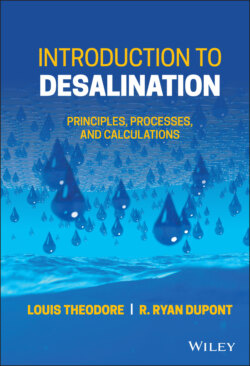Читать книгу Introduction to Desalination - Louis Theodore - Страница 17
1.5.1 Evaporation Processes
ОглавлениеThe oldest and best developed process for saline water conversion is the evaporation (or what some define as distillation) method. While there are many desalination technologies in use or being developed today, desalination began using evaporative processes. These evaporative desalination techniques were recognized over 2,000 years ago when Aristotle wrote in 320 B.C., “saltwater, when it turns into vapor, becomes sweet and the vapor does not form saltwater again when it condenses.” Evaporation remains the major method today for commercial production of fresh water from seawater. In principle, evaporation is the simplest method. Seawater is boiled in an evaporator (Flynn et al. 2019 ; Theodore 2014; Theodore et al. 2017) by passing hot steam through a steam chest where the steam condenses on the inside of the tubes of the chest and is usually returned to the boiler. The vapors rising from the seawater feed are cooled in a condenser and thus converted into pure liquid water which is collected in a storage vessel. The resulting concentrated brine solution is continuously or intermittently withdrawn from the evaporator. The most advanced commercial evaporation processes are the following:
1 Multiple-Effect Evaporation.
2 Flash Evaporation.
3 Vapor Compression Evaporation.
Details of these processes are provided in Chapter 10.
